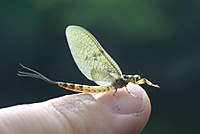| Revision as of 14:24, 13 January 2006 editWeregerbil (talk | contribs)Extended confirmed users12,447 edits Popups-assisted reversion to revision 34568687← Previous edit | Revision as of 20:42, 30 January 2006 edit undoGdrbot (talk | contribs)45,158 editsm nomialbot — converted multi-template taxobox to {{Taxobox}}Next edit → | ||
| Line 1: | Line 1: | ||
| {{Taxobox |
{{Taxobox | ||
| | color = pink | |||
| | name = Mayflies | |||
| | image = Haft.jpg | |||
| | image_width = 200px | |||
| {{Taxobox begin placement | color = pink}} | |||
| | regnum = ]ia | |||
| | phylum = ] | |||
| | classis = ] | |||
| | ordo = '''Ephemeroptera''' | |||
| | ordo_authority = Hyatt & Arms, 1891 | |||
| {{Taxobox end placement}} | |||
| | subdivision_ranks = Suborders | |||
| {{Taxobox_section_subdivision | color = pink | plural_taxon = Suborders}} | |||
| | subdivision = | |||
| '''Suborder ]'''<br> | '''Suborder ]'''<br> | ||
| Superfamily ]<br> | Superfamily ]<br> | ||
| Line 39: | Line 42: | ||
| ]<br> | ]<br> | ||
| ]<br> | ]<br> | ||
| }} | |||
| {{Taxobox_end}} | |||
| The '''mayflies''' are an ] ('''Ephemeroptera''' meaning "but for a day wing") of ]s that grow up in ], and live very briefly as adults, as little as a few hours but more typically a day or two. About 2,500 species in 23 families are known. Other names for these insects include '''dayfly''', '''shadfly''', '''fishfly''', and '''Canadian soldier'''. | The '''mayflies''' are an ] ('''Ephemeroptera''' meaning "but for a day wing") of ]s that grow up in ], and live very briefly as adults, as little as a few hours but more typically a day or two. About 2,500 species in 23 families are known. Other names for these insects include '''dayfly''', '''shadfly''', '''fishfly''', and '''Canadian soldier'''. | ||
Revision as of 20:42, 30 January 2006
| Mayflies | |
|---|---|

| |
| Scientific classification | |
| Kingdom: | Animalia |
| Phylum: | Arthropoda |
| Class: | Insecta |
| Order: | Ephemeroptera Hyatt & Arms, 1891 |
| Suborders | |
|
Suborder Schistonota | |
The mayflies are an order (Ephemeroptera meaning "but for a day wing") of insects that grow up in fresh water, and live very briefly as adults, as little as a few hours but more typically a day or two. About 2,500 species in 23 families are known. Other names for these insects include dayfly, shadfly, fishfly, and Canadian soldier.
The nymphs live on the bottom of lakes and streams, usually under rocks, clinging to vegetation or digging in silt or mud. Most species are vegetarian, with some types being predators. The nymph stage may last from several months to as much as several years, with a number of molts along the way. Mayfly nymphs are distinctive in having external pairs of gills along the abdomen, as well as 2-3 long cerci at the end, giving them a bit of a frilly appearance. In the last aquatic stage, small wings are visible, a characteristic of hemimetabolous insects, or those having an incomplete metamorphosis. Mayflies are unique among the winged insects in that they molt one more time after acquiring functional wings; this second-to-last winged instar is usually very short, often a matter of hours, and is known as a subimago or to fly fishermen as a dun. This stage is a favorite food of many fish, and many fishing flies are modeled to resemble them.
The adult's one purpose is to reproduce; the mouthparts are useless, and the digestive system filled with air. The wings are large and shiny, with the forewings much larger than the hind wings. The males' eyes are usually large, and the front legs long, used to grasp females and often held in front when resting. In some species, all legs aside from the males' front legs are useless, and adults' entire lives are spent in flight.
It often happens that all the mayflies in a population mature at once, and for a day or two in the springtime, mayflies will be everywhere, dancing around each other in large groups, or resting on every available surface. This happens in mid-June on the Tisza River; this kind of mayfly is called the tiszavirág or "Tisza flower".
Both immature and adult mayflies are an important part of the food chain, particularly for carnivorous fish like trout.
Mayflies are also an industrial nuisance, as the large population of dead adults can clog the intakes of air and water supply systems. A good example of this is found in the nuclear industry when plants located near fresh water can have their cooling water intakes clogged by the corpses.
In literature mayflies can sometimes illustrate something hard to find and/or obtain.
There are two species, Pecatonica River mayfly and the Robust burrowing mayfly, that have recently become extinct. The Large blue lake mayfly is listed as vulnerable.
In certain regions of New Guinea and Africa, mayflies are eaten when they emerge en masse on a certain day.
External link
http://www.sg.ohio-state.edu/PDFS/PUBLICATIONS/FS/FS-069.PDF
Sources
- Firefly Encyclopedia of Insects and Spiders, edited by Christopher O'Toole, ISBN 1-55297-612-2, 2002